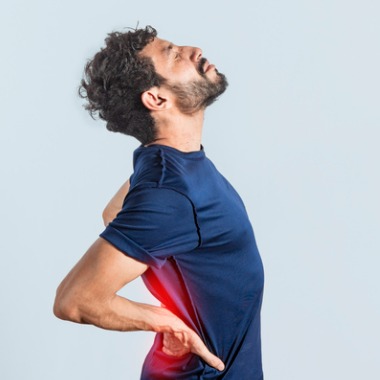Low Back Pain: Not Always Spine-related
Did you know that low back pain is not always spine-related? In fact, there are many other things that can cause low-back pain. One of these is sacroiliac (SI) joint dysfunction, a condition in which the SI joint (the joint where the sacrum and the ilium meet) becomes inflamed or dysfunctional. This can cause pain in the lower back, as well as other symptoms like difficulty standing or walking.

If you are experiencing low back pain, it’s important to seek a diagnosis from a provider who is familiar with SI joint dysfunction and other underdiagnosed causes of low back pain.
Common Risk Factors of Lower Back Pain
Low back pain can occur from a number of different lifestyle factors, including:
Poor Posture: Years of poor posture can lead to muscle imbalances and weakness, which can contribute to lower back pain.
Inactivity or Sedentary Lifestyle: A sedentary lifestyle can lead to weak and tight muscles, as well as joint stiffness.
Overuse Injuries: Repetitive motions or activities that put a strain on the back can lead to overuse injuries or early degeneration.
Wearing High Heels: Wearing high heels can alter your posture and put extra strain on your lower back.
Obesity: Carrying around extra weight puts additional strain on the spinal discs and can lead to low back pain.
Pregnancy: The added weight and changes in posture and hormones during pregnancy can lead to lower back pain for many women.
Spine Conditions That Cause Lower Back Pain
While the above lifestyle factors may place you at greater risk of developing low back pain, there are also a number of spine conditions that can cause low back pain, including:
Degenerative Disc Disease: This is a condition in which the discs between the vertebrae begin to degenerate.
Spinal Stenosis: Spinal stenosis occurs when the spaces within the spine narrow, putting pressure on the spinal cord and nerves.
Herniated Disc: A herniated disc or slipped disc is when the center of a spinal disc breaks through the annulus fibrosis (the outer layer of the disc).
Facet Joint Arthritis: Arthritis of the facet joints (the joints between the vertebrae) can lead to pain and stiffness in the lower back.
Spondylolisthesis: Spondylolisthesis is a condition in which one vertebra slips forward over the one below it.
Non-Spine-Related Conditions That Cause Low Back Pain
In addition to the above spine conditions that can cause lower back pain, there are also a number of non-spine-related conditions that can lead to low back pain. These include:
SI Joint Dysfunction: As mentioned earlier, SI joint dysfunction is a condition in which the SI joint becomes inflamed or dysfunctional. This can cause lower back pain, as well as other symptoms like difficulty, standing or walking.
Fibromyalgia: Fibromyalgia is a condition that causes widespread pain and tenderness throughout the body, as well as fatigue and sleep problems.
Piriformis Syndrome: Piriformis syndrome is a condition in which the piriformis muscle (a small muscle in the buttocks) becomes tight or spasms, causing lower back pain.
Iliopsoas Tendonitis: Iliopsoas tendonitis is a condition in which the iliopsoas tendon (the tendon that attaches the iliopsoas muscle to the hip) becomes inflamed. This can cause pain in the lower back and hip.
Get Help for Lower Back Pain
If you’re experiencing low back pain, it’s important to seek a diagnosis from a provider who is familiar with SI joint dysfunction and other underdiagnosed causes of low back pain. There are many potential causes of low back pain, and it’s important to get an accurate diagnosis so that you can receive the most effective treatment.
LinQ SI Joint Stabilization System for SI Joint Dysfunction
If you have been diagnosed with SI joint dysfunction, the LinQ SI Joint Stabilization System may be able to help. The LinQ system is a minimally invasive treatment that uses a small implant to stabilize the SI joint. This may provide long-term pain relief and allow you to return to your normal activities faster than traditional anterior surgeries.
If you’re suffering from low back pain, contact us today to learn more about LinQ and find a physician near you trained in diagnosing and treating SI joint dysfunction.



